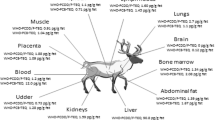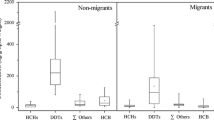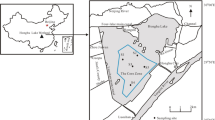Abstract
Organochlorine analysis was performed on adult and juvenile farm-raised mallards (Anas platyrhynchos) released and collected at three experimental sites in southern Ontario: Hamilton Harbour Confined Disposal Facility (CDF); Winona Sewage Lagoons (SL); and Big Creek Marsh, Canada. Collections were scheduled at 10, 30, and 70 days after release. Hamilton Harbour CDF and Winona SL are known to be contaminated whereas Big Creek Marsh is a relatively clean, natural site. All sites are important resting and feeding areas for migratory and resident waterfowl. Breast muscle concentrations of polychlorobiphenyls (PCBs) in ducks collected 10 days after release (160.8 μg/kg, wet wt) at Hamilton Harbour CDF were more than 5300 times greater than day “0” birds (0.03 μg/kg). All ducks collected from Hamilton Harbour CDF had PCB concentrations exceeding Health and Welfare Canada and United States Food and Drug Administration (FDA) guidelines for edible poultry. Concentrations of DDE (216.9 μg/kg), hexachlorobenzene (0.9 μg/kg), dieldrin (1.9 μg/kg), and 1,2,4,5,-tetrachlorobenzene (24.9 μg/kg) were significantly elevated in ducks utilizing Winona SL. Concentrations of 1,2,3,4-tetrachlorobenzene, mirex, and photomirex were elevated at one or more of the sites. Ducks from Big Creek Marsh had lower contaminant concentrations than ducks from the other study sites. It is not clear whether bioaccumulation of organochlorines at these sites would pose a potential hazard to migratory and resident mallards; however, other duck species such as diving ducks that have more contact with sediments and sediment-derived foods would probably be at much higher risk.
Similar content being viewed by others
References
Belanger L, Couture R (1988) Use of man-made ponds by dabbling duck broods. J Wildl Manage 52(4):718–723
Bush B, Tumasonic CF, Baker FD (1974) Toxicity and persistence of PCB homologs and isomers in the avian system. Arch Environ Contam Toxicol 2:195–212
Combs GF, Jr, Scott ML (1977) The effects of polychlorinated biphenyls on birds. World's Poultry Sci J 33:31–46
Dobos RZ, Painter DS, Mudroch A (1990) Contaminants in vegetation, earthworms and dredged sediment in Confined Disposal Facilities on the Canadian Great Lakes. National Water Research Institute, Burlington, Ontario, Contribution No. 90–35
—, —, — (1991) Contaminants in wildlife utilizing confined disposal facilities. Int J Environ Pollut 1(1/2):73–86
Dobos RZ, Struger J, Blokpoel H, Weseloh DV (1988) The status of colonial waterbirds nesting at Hamilton Harbour, Lake Ontario, 1959–1987. Ontario Birds 6(2):51–60
FDA, United States Food and Drug Administration (1979) Polychlorinated biphenyls (PCBs); reduction of tolerances. Fed Reg 44(Jun): 38330–38340
Gebauer MB (1991) Waterbirds at the Hamilton Harbour Confined Disposal Facilities in 1990. Wood Duck 44(5):74–78
Goldberg DR, Yuill TM (1990) Effects of sewage sludge on the immune defenses of mallards. Environ Res 51:209–217
Haegele MA, Hudson RH (1974) Eggshell thinning and residues in mallards one year after DDE exposure. Arch Environ Contam Toxicol 2(4):356–363
Harlow HE, Hodson PV (1988) Chemical contamination of Hamilton Harbour: A review. Canadian Technical Report of Fisheries and Aquatic Sciences, No. 1603. Department of Fisheries and Oceans, Burlington, Ontario, Canada
Health and Welfare Canada (1991) Table 2, Division 15, Canadian Food and Drug Regulations
Heath RC, Spann JW, Kreitzer JF (1969) Marked DDE impairment of mallard reproduction in controlled studies, Nature 224:47–48
Hebert CE, Haffner GD, Weis IM, Lazar R, Montour L (1990) Organochlorine contaminants in duck populations of Walpole Island. J Great Lakes Res 16(1):21–26
Kim KS, Pastel MJ, Kim JS, Stone WB (1984) Levels of polychlorinated biphenyls, DDE and Mirex in waterfowl collected in New York State. 1979–80. Arch Environ Contam Toxicol 13:373–381
Kubiak TJ, Harris HJ, Smith LM, Schwartz TR, Stalling DL, Trick JA, Sileo L, Docherty DE, Erdman TC (1989) Microcontaminants and reproductive impairment of the Forster's tern on Green Bay, Lake Michigan—1983. Arch Environ Contam Toxicol 18:706–727
Longcore JR, Stendell, RC (1977) Shell thinning and reproductive impairment in black ducks after cessation of DDE dosage. Arch Environ Contam Toxicol 6:293–304
Mayer T, Manning PG (1990) Inorganic contaminants in suspended solids from Hamilton Harbour. J Great Lakes Res 16(2):299–318
MOE, Ontario Ministry of the Environment (1987) Handbook for dredging and dredged material disposal in Ontario, part A: Legislation, policies, sediment classification and disposal. Draft. June, 1987, 41 pp
--, MNR, Ministry of Natural Resources (1990) Guide to eating Ontario sport fish, 14 ed, rev
Mora MA, Anderson DW, Mount ME (1987) Seasonal variation of body condition and organochlorines in wild ducks from California and Mexico. J Wildl Manage 51(1):132–141
Mora MA, Anderson DW (1991) Seasonal and geographical variation of organochlorine residues in birds from Northwest Mexico. Arch Environ Contam Toxicol 21:541–548
Noble DG, Elliot JE (1990) Levels of contaminants in Canadian raptors, 1966 to 1988; effects and temporal trends. Can Field- Naturalist 104(2):222–243.
Owen M, Cook WA (1977) Variations in body weight, wing length and condition of mallard Anas platyrhynchos and their relationship to environmental changes. J Zool London 183:377–395
Peakall DB, Miller DS, Kinter WB (1975) Prolonged eggshell thinning caused by DDE in the duck. Nature 254:421
Peterson SR, Ellarson RS (1978) pp'DDE, polychlorinated biphenyls and endrin in oldsquaws in North America, 1969–73. Pesticides Monitoring J 11(4):170–181
Phillips DJ, Segar DA (1986) Use of bioindicators in monitoring conservative contaminants: program design imperatives. Marine Pollut Bull 17(1):10–17
Piest LA, Sowls LK (1985) Breeding duck use of a sewage marsh in Arizona. J Wildl Manage 49(3):580–585
Poulton DJ (1986) Hamilton Harbour trace elements 1982–83: Loadings to, and concentrations in the Harbour, Great Lakes Section, Water Resources Branch, Burlington, Ontario, Canada
Rodrigue J, DesGranges J, Titman R (1992) Use of Pekin ducks (Anas platyrhynchos) as a bioindicator of contamination by bioaccumulative substances in the natural environment (St. Lawrence, Canada), In: Bohac J (ed), Proc VIth Int Conf Bioindicatores Deteriorisationis Regionis. Institute of Landscape Ecology CAS, České Budějovice (in press)
Schladweiler JL, Tester JR (1972) Survival and behavior of handreared mallards released in the wild. J Wildl Manage 36(4): 1118–1127
Scott JM, Wiens JA, Claeys RR (1975) Organochlorine levels associated with a common murre die-off in Oregon. J Wildl Manage 39(2):310–320
Smith VE, Spurr JM, Filkins JC, Jones JJ (1985) Organochlorine contaminants of wintering ducks foraging on Detroit River sediments. J Great Lakes Res 11(3):231–246
Stickel WH, Stickel LF, Dyrland RA, Hughes DL (1984) DDE in birds: Lethal residues and loss rates. Arch Environ Contam Toxicol 13:1–6
Weseloh DV (1986) Preliminary results of contaminant studies in wild and domestic ducks from Walpole Island and Hamilton Harbour, 1985–86. Canadian Wildlife Service, Burlington, Ontario, Unpubl Rep
Weseloh DV, Struger J, Hebert CE (1993) White Pekin ducks (Anas platyrhynchos) as monitors of organochlorine and metal contamination in the Great Lakes. Draft Report, Canadian Wildlife Service, Canada Centre for Inland Waters, Burlington, Ontario, Canada
White DH, Cromartie E (1985) Bird use and heavy metal accumulation in waterbirds at dredge disposal impoundments, Corpus Christi, Texas. Bull Environ Contam Toxicol 34:295–300
White DH, Krynitsky AJ (1986) Wildlife in some areas of New Mexico and Texas accumulate elevated DDE residues, 1983. Arch Environ Contam Toxicol 15:149–157
White DH, Stendell RC, Mulhern BM (1979) Relations of wintering canvasbacks to environmental pollutants-Chesapeake Bay, Maryland. Wilson Bull 91(2):279–287
Won H, Turle R (1987) 1. Methods of analysis, 2. Internal Quality Assurance Protocol, Report CWS-87-00, Ottawa
Zar JH (1984) Biostatistical analysis, 2nd ed. Prentice Hall Inc, Englewood Cliffs, NJ
Author information
Authors and Affiliations
Rights and permissions
About this article
Cite this article
Gebauer, M.B., Weseloh, D.V. Accumulation of organic contaminants in sentinel mallards utilizing confined disposal facilities at Hamilton Harbour, Lake Ontario, Canada. Arch. Environ. Contam. Toxicol. 25, 234–243 (1993). https://doi.org/10.1007/BF00212135
Received:
Revised:
Issue Date:
DOI: https://doi.org/10.1007/BF00212135




